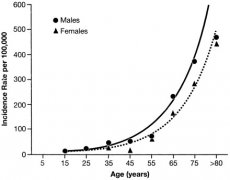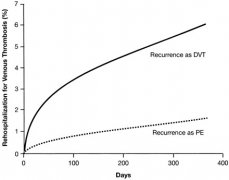|
深静脉血栓(DVT)和肺栓塞(PE)是有区别但是有同一动态疾病过程的相关概念,被称为静脉血栓栓塞(VTE)。在美国至少每年有200,000新病例发生,包括94,000例肺栓塞,23/100,000/年发病率,如果没有治疗,肺栓塞死亡率将近30%,导致每年50,000人死亡。根据尸检研究,将近2/3肺栓塞病人没有被诊断。
Cina et al.[42]在美国至少每年死于100,000肺动脉栓塞。没有选择的尸检超过10%发现栓子。所有病人0.1%死于肺栓塞。进一步说,复发性血栓和血栓栓塞比我们曾经相信的更常见[43]。
1. Nicolaides AN, Breddin HK, Fareed J, et al. Prevention of venous thromboembolism International Comsensns Statement, Guideline compiled in accordance with the scientific evidence[J]. Int angiol,2001,20(1):1- 37. 2. Nevelsteen A. Prophylaxis of venous thromboembolism[J]. Inter Angiol, 1996, 15(Suppl):3- 4. 3. Baldwin ZK, Comerota AJ, SchwartzLB, et al. Catheter-directed throm-bolysisfor deep venous thrombosis[J]. Vas Endvasc Surg, 2004,38(1):1-9. [4]Heit JA,Silverstein MD,Mohr DN,et al.The epidemiology of venous thromboembolism in the community[J].Thromb Haemost,2001,86(1):452-463. 5. Cushman M. Epidemiology and risk factors for venous thrombosis. Semin Hematol. 2007 Apr;44(2):62-9. 7. Turpie AG, Chin BS, Lip GY. Venous thromboembolism:Pathophysiology, clinical features, and prevention. Br Med J. 2002;325:887–890. 8. Geerts WH, Pineo GF, Heit JA, et al. Prevention of venous thromboembolism: The Seventh ACCP Conference on Antithrombotic and Thrombolytic Therapy. Chest.2004;126:338S–400S. 9. Stein PD, Beemath A, Olson RE. Trends in the incidence of pulmonary embolism and deep venous thrombosis in hospitalized patients. Am J Cardiol. 2005;95:1525–1526. 10. Futterman LG, Lemberg L. A silent killer—often preventable. Am J Crit Care. 2004;13:431–436. 11. Ageno W, Turpie AGG. Deep venous thrombosis in the medically ill. Curr Hematol Rep. 2002;1:73–77. 12. Anderson FA Jr, Wheeler HB. Physician practices in the management of venous thromboembolism: A community-wide survey. J Vasc Surg. 1992;16:707–714. 13. Michota FA. Venous thromboembolism prophylaxis in medical patients. Curr Opin Cardiol. 2004;19:570–574. 14. Kucher N, Koo S, Quiroz R, et al. Electronic alerts to prevent venous thromboembolism among hospitalized patients. N Engl J Med. 2005;352:969–977. 15. Nutescu EA. Emerging options in the treatment of venous thromboembolism. Am J Health Syst Pharm. 2004;61 (Suppl 7):S12–S17. 16. Cohen M. Antithrombotic therapy in cardiovascular patients: Introduction. Am J Cardiol. 2005;1:7–8. 17. Kearon C. Epidemiology of venous thromboembolism.Semin Vasc Med. 2001;1:7–26. 18. Sandler DA, Martin JF. Autopsy proven pulmonary embolism in hospital patients: Are we detecting enough deep vein thrombosis? J R Soc Med. 1989;82:203–205 19. Heit JA.Venous thromboembolism epidemiology:Implications for prevention and management. Semin Thromb Hemost. 2002;28(Suppl 2):3–13. 20. White RH.The epidemiology of venous thromboembolism.Circulation.2003;107(Suppl 1):14–18. 21. Kearon C. Epidemiology of venous thromboembolism.Semin Vasc Med. 2001;1:7–26. 22. Silverstein MD, Heit JA, Mohr DN, et al. Trends in the incidence of deep vein thrombosis and pulmonary embolism: A 25-year population-based study. Arch Intern Med. 1998;158:585–593. 23. Turpie AG, Chin BS, Lip GY. Venous thromboembolism:Pathophysiology, clinical features, and prevention. Br Med J. 2002;325:887–890. 24. Kahn SR, Solymoss S, Lamping DL, Abenhaim L. Long-term outcomes after deep vein thrombosis: Postphlebitic syndrome and quality of life. J Gen Intern Med. 2000;15:425–429. 25. Oger E. Incidence of venous thromboembolism: A community-based study in Western France. Thromb Haemost. 2000;83:657–660. |



